
The Lookup Function is a fantastic time-saver. It is a perfect example of how Excel can “do the work for you”. For those who have not heard of the lookup function, this post will provide you with a great introduction to these two functions and how they can be used to save time.
Syntax
An important aspect of understanding any function in Excel is the ability to identify the parameters or syntax required.
There are two types of lookup functions: VLOOKUP (used for vertically presented data) and HLOOKUP (used for horizontally presented data). We will look at the VLOOKUP function which is shown below:
=VLOOKUP(lookup_value, table_array, col_index_number, [range_lookup])
| Lookup_Value | The lookup value is the cell reference containing the value you wish to lookup. |
| Table_Array | The table_array is the location of the data containing the answer you wish to lookup. |
| Col_Index_Number | The col_index_number is the column number within the table where the answer is being returned from. |
| Range_Lookup | The range_lookup tells Excel to find the closest match, rather than looking for exact matches. |
Create a Vlookup
In our first example, we are using an employee bonus scheduled where want to Excel to look at the number of years each member has been employed, then go to our bonus schedule, which is laid out in a vertical format, and identify how much their bonus is based on their years of employment. In this example I’m only looking at 6 staff members so technically I could manually look these up myself. Imagine now if I had 500 employees which I needed to perform this task for – it would be very time-consuming if I did this manually. This is where the Vlookup is going to save me ALOT of time.
To create an Excel vlookup function, follow these steps:
- Open Microsoft Excel
- If you wish to use an existing file which contains a table of data suitable for this exercise, press Ctrl + F12, the Open dialog box will appear allowing you to locate the file and click Open
- If you do not have an existing file, create a sample file such as the one shown below:
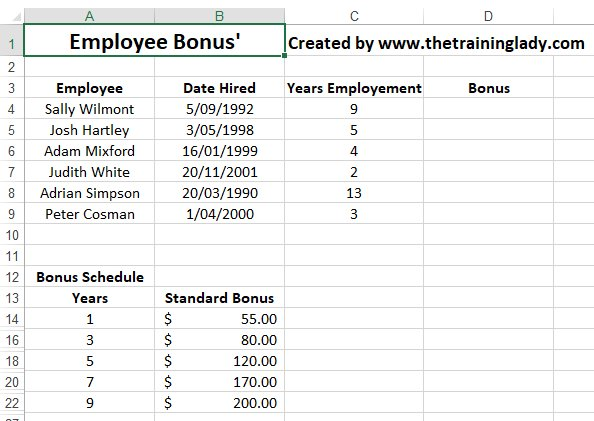
- From the sample above you can see our Bonus Schedule table is displayed in cells A14:B22.
TIP: In a real-world scenario I would recommend having your table of data on a separate worksheet, separate from the data you wish to lookup.
- Place your cursor in cell D4
- We will use the Function Wizard to provide some guidance for new users
- Select the Formulas tab and click the Insert Function button OR click the Insert Function button located on the Formula Bar
- The Insert Function dialog box will appear:

- In the Search for a function box type the function name (in this example, type vlookup) you are searching for, or if you are unsure which function to use, type in a description of what you wish to achieve, then click Go
- A list of functions which are applicable will be displayed

- By clicking on each function displayed you can read a description for each below the list
- If you are attempting to use a new function, click the Help on this function link in the bottom left of the dialog box, this will give you a full overview of the function and how it can be used
- Select Vlookup from the list and click OK
- The Function Arguments dialog box will now appear:

- Place your cursor in the Lookup_value field; within this field, we must select the cell which contains the value we want to “lookup”
- This field has the Collapse dialog box button on the right side which means that Excel will allow you to use the mouse and select any cell on the worksheet, if the dialog box is blocking access to the cell you need to click on, click the Collapse button otherwise, just leave the entire Function Arguments dialog open and select the correct cell

- Click and select cell C4
- Now move your cursor to the Table_array field
- You must now select the location of your table data, be sure to only select the cells which contain data, do not include the headings
- Select cells A14:B22
- Because we will be using AutoFill to copy this function to other cells, place your cursor within the A14 reference and press F4 on the keyboard once to make the reference “Absolute”. Repeat for the B22 reference.
- The Table_array should look as follows:

- Move your cursor to the Col_index_number field
- You must now enter the numerical value of the column you wish to retrieve the match result from
- In this example, we want to return the value of the bonus amount. It is important to use the value of the column within the table data and not the column number within Excel. See the examples below:
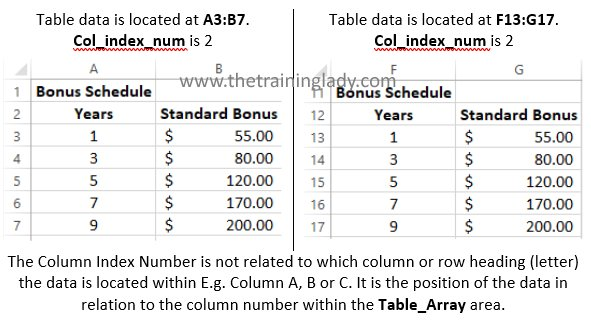
- Enter the value 2 into the Col_index_num field
- Now move your cursor to the range_lookup field. This field determines if you want Excel to find you the closest match or an exact match.
Info: You will notice in our table_array that only the years where an employee will receive a bonus are listed. Year 2, 4, 6 and 8 are not listed in the table as employees do not receive a bonus in these years. If you leave the range_lookup field empty, Excel will find the nearest match, meaning that employees who have been employed for 2, 4, 6 and 8 years will still receive a bonus when they should not. To avoid this issue you can use the range_lookup field to tell Excel to find only an Exact match.
- In the range_lookup field type False
- Click OK
- The answer $200 will be returned as the bonus amount for the first person in my example
- You can double-check the answer by looking up the bonus amount for 9 years of employment, which is $200
AutoFill the function
There is no need to repeat the process to create the lookup function again. Use the AutoFill feature to copy the formula to other cells. Because we used absolute cell referencing (the dollar $ symbol in the cell references for the bonus schedule table), we can AutoFill this and our answers will be accurate for all employees. It is worthwhile having a go at a few of the examples yourself so that you get more than one practice using the Vlookup function – remember practice makes perfect!
- Select cell D4
- Place your cursor on the bottom right corner of the cell till the mouse cursor changes to a +
- Hold down the left mouse button and drag it down to the bottom of cell D9 and release the mouse button
- The function will now be copied down the column

What about the errors?
You spot them too? The #N/A error for cell D8 is in fact Excel telling you that there was not an exact match for those particular values. The value being looked up is 13 years of employment, our Bonus Schedule table only goes up to 9 years of employment, therefore, Excel has responded with an error message. A common question I hear is: “I don’t want errors on my spreadsheet, how can I make this look better?”.
Here is my tip to fix this and make your spreadsheet look better.
- Adjust the table_array area to include ALL possible answers. In this example, add entries for years 2, 4, 6, 8, 10, 11, 12 etc. In the bonus amount simply enter $0
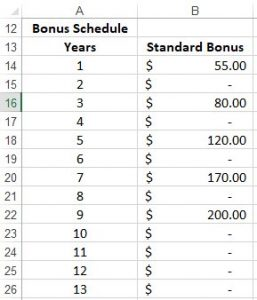
- If you do not wish to have these additional years displayed, hide the rows and leave only the rows with value amounts displayed. You can see below that rows 15, 17, 19, 21, 23-26 are hidden on the worksheet.
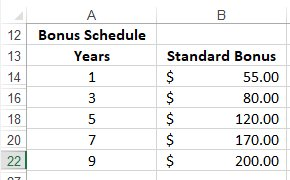
- You may need to adjust the table_array cell references within the Vlookup in case it does not automatically acknowledge these new entries
Create a Hlookup in Excel
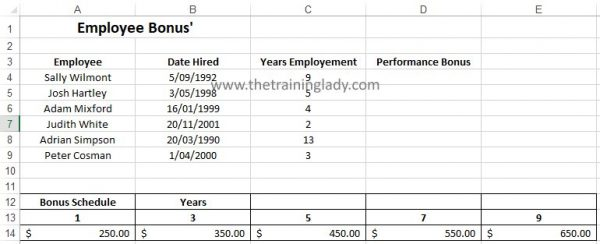
As mentioned, there are two lookup functions. Vlookup and Hlookup. In the above example, we have utilised the Vlookup option as the table_array data is displayed in a vertical layout. The Excel Hlookup function is identical however can be used where the table_array is displayed horizontally, as shown below:
As an example, the Hlookup function used in cell D4 would look as shown below:
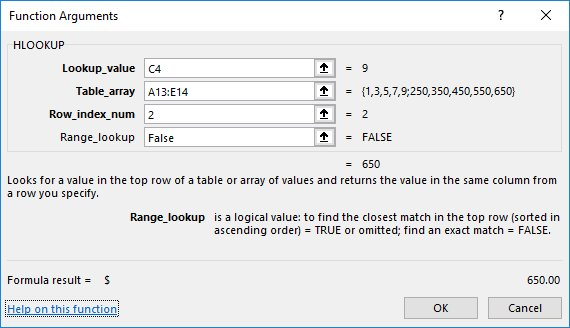
You have now completed a basic lookup function in Excel. I hope this gives you an introduction to the Lookup function and how it can provide time-saving benefits.
Reference: https://www.thetraininglady.com/vlookup-function/
